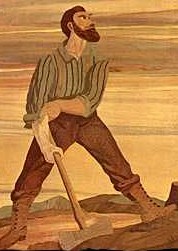 |
28 1959 The 'Paul Bunyan'
Machine
Scrooge is trying to hide his money from
the Beagle Boys (see U$01, U$21,
U$51 and U$63)
by putting the money into hollow trees. In the
first two adventure storieswith the Beagle Boys,
the Beagle Boys more or less stumbled over the
money. This time the Beagle Boys are both
actively and intelligently seeking the money.
The name of Paul Bunian is a reference to a
popular set of North American stories about a
giant lumberjack whose 'legend' was created
in the bunkhouses of logging camps, by ordinary
working men, while they gathered around the
glowing woodstoves on cold winter evenings. The
lumberjacks heard and then retold the fables,
often weaving in local or personal embellishments
as they passed the tales on. |
|